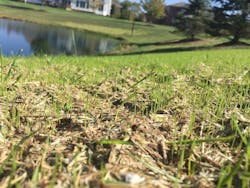About the author: Jill Pack, CPESC, is customer service and marketing manager for North American Green. Pack can be reached at [email protected] or 812.867.8677.
Situated in the heart of Carmel, Ind., the Village of West Clay is a community featuring homes, commercial centers, parks and community space. The Village of West Clay Owners Assn. employs its own maintenance crew that is charged with the upkeep of the 719-acre community and its green space, which includes nearly 25 ponds. Elgin Pond is one of many ponds that experienced erosion and vegetation issues.
As part of standard operating procedures, when new ponds were developed, temporary rolled erosion control blankets were used to protect the slopes from erosion and aid in vegetation establishment. While this procedure worked well for the initial build, it often did not maintain great vegetation establishment or protect areas that needed repair due to long-term erosion.
Over time, erosion occurred due to the general wear and tear of vegetation and storm runoff damage. The maintenance team needed a new system to help protect the freshly graded and seeded pond repairs that became necessary over time. Because repair areas usually were intermittent along the pond banks with irregular dimensions, placing erosion control blankets on the areas was tedious work. The team also found new topsoil and seeding usually washed away during rain storms.
Pond banks affected by rill erosion and uneven vegetation growth were cultivated to a 6-in. depth.
A New Direction
Searching for a solution to the problem, Derrick Donnella, operations manager, and Gary Vandagrifft, landscape manager, for the Village of West Clay Owners Assn., contacted Kenney Outdoor Solutions for guidance. With the help of Cliff Hankins and Jamie Petrowski, construction and landscape product sales representatives for Kenney, they surveyed the areas and analyzed options.
While at first glance, the moderate 3:1 (H:V) pond slopes and moderate clay soils did not seem difficult to repair, they ultimately found that when repair topsoil was placed over the compact clay, a slip plane occurred that made the repair areas more vulnerable to failure when subjected to runoff. The hardened clays also were slow to establish vegetation, which prolonged the high-risk phase.
The proposed solution was to cultivate the repair areas to a depth of approximately 6 in. This process would help break up the hardened clays. It also offered a prime opportunity to incorporate a soil fertilizer. A Toro Dingo TX1000 with a soil cultivator attachment was used to prepare the pond banks for repair. The soil then was treated with a 21-14-7 starter fertilizer.
For erosion protection, the HydraMax HydraCM Steep Slope Matrix was chosen for surface protection. It is a bonded fiber matrix that incorporates straw and reclaimed cotton plant fibers with a blend of tackifiers and activators. The blend of fibers allows porous surface erosion protection that locks soil in place, while offering enough open area for quick vegetation growth.
To apply the hydraulic mulch, the crew utilized a Turfmaker 550 hydroseeding machine to mix and apply the bonded fiber matrix product. The seed mix could be mixed and applied in one step, saving time and water. The fiber matrix was applied at a rate of 3,000 lb per acre with a 90% fescue and 10% perennial rye seed mix. The Elgin pond repair occurred in the first week of October, near the end of the Indiana fall seeding window.
“We found that we could use half of the manpower and still spend a third less time on repairs compared to blanketing an area of similar size,” said Holly Vandegriff, landscape specialist for the Village of West Clay.
One day after the mulch application, the site experienced its first rain event, with a second rain event occurring within the next week. Even without seed germination and root support, the slopes held under the runoff. Within two to three weeks, the site had completely filled in and established.
“I was impressed with the results immediately afterwards,” Vandagrifft said. “The rain came at the right time, and I didn’t have to worry or go back to see if the product failed as I was accustomed to doing on blanketed projects."


